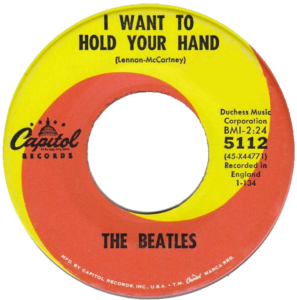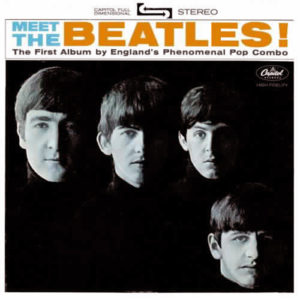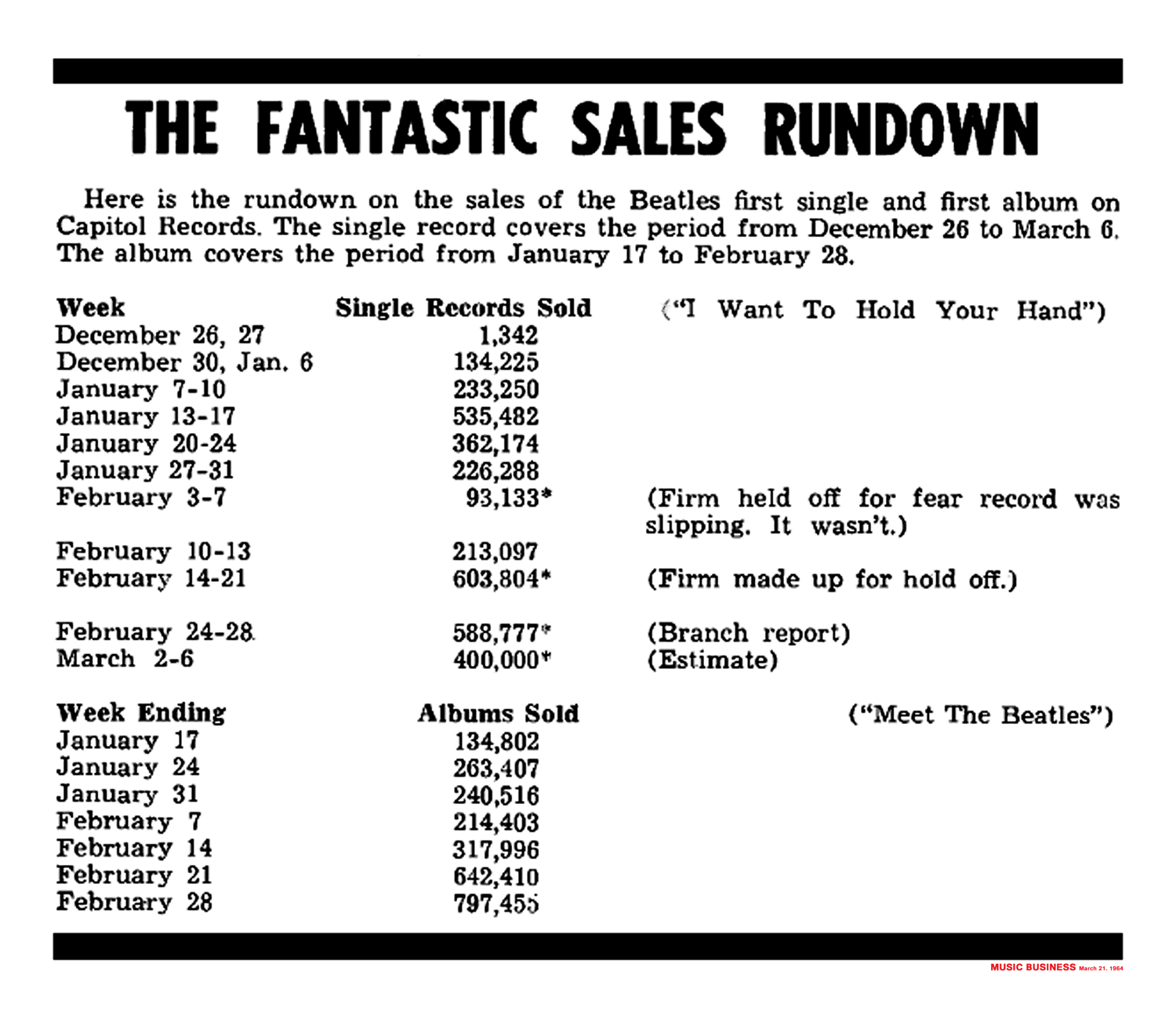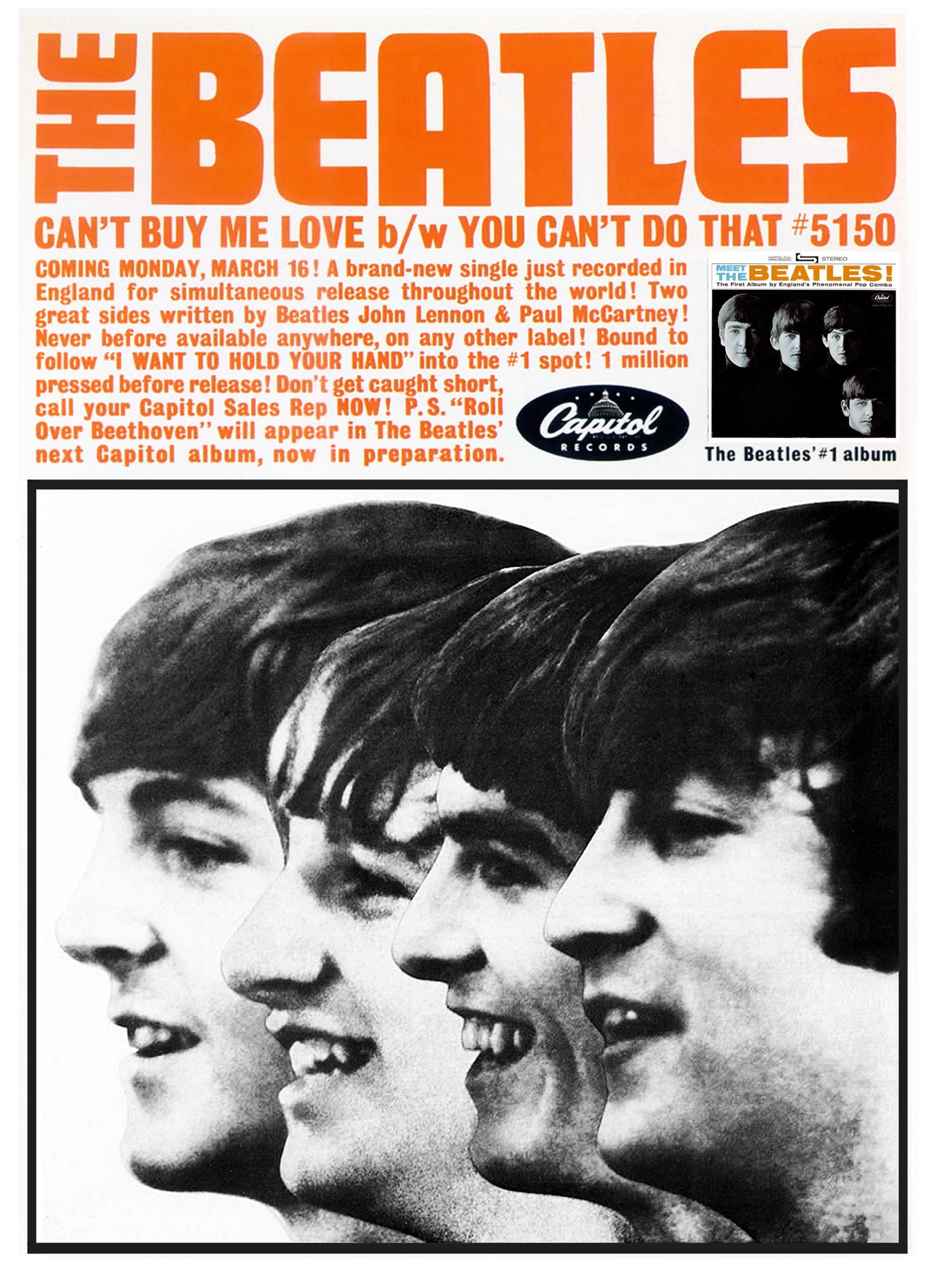 How Capitol Records Prepped The Beatles’ Single and Album to Satisfy Overwhelming Demand in the United States
How Capitol Records Prepped The Beatles’ Single and Album to Satisfy Overwhelming Demand in the United States
Music Business March 21, 1964
ONE THING IS CERTAIN — the record industry will never be the same as it was before The Beatles, and neither will Capitol Records.

The incredible success of The Beatles on record (3.5 million singles and 3.5 million LP’s on Capitol alone, and million-plus sellers on both Vee Jay and Swan), and the attendant success of the lads on TV, in personal appearances and in media coverage, indicates that records are the most dynamic exposure medium available for young artists. Records far outdistance TV and movies, live appearances or anything else in creating a national image in a hurry.
And it also indicates that the record industry, working with its partner — radio — can expect at any time that one of its artists overnight can become an overwhelming national favorite, to an extent that would have surprised even the most optimistic record manufacturer less than two years ago.
IN A YEAR AND A HALF, the record industry has seen three massive break-outs of records featuring new artists, who-until their records were exposed — were relatively unknown. In the fall of 1962 the album of folk song parodies by Allan Sherman on Warner Bros. sold more than a million in little over two months. In November and December of 1962 and January of 1963, the album by Vaughn Meader on Cadence, “The First Family”, sold four million LP’s and broke every existing LP sales record.
 And less than a year later, The Beatles did it again. There have been, of course, massive sellers before Sherman, Meader and The Beatles. Elvis Presley is the outstanding example on the pop side. Johnnie Ray did it with his smash hit; “Cry”. And there have been a number of show albums or sound tracks, “My Fair Lady”, “South Pacific”, “The Sound Of Music”, “West Side Story”, which have racked up sales in the millions. But these have occurred sporadically; the demand has not been concentrated in such a short time span as with the Sherman, Meader and Beatles releases.
And less than a year later, The Beatles did it again. There have been, of course, massive sellers before Sherman, Meader and The Beatles. Elvis Presley is the outstanding example on the pop side. Johnnie Ray did it with his smash hit; “Cry”. And there have been a number of show albums or sound tracks, “My Fair Lady”, “South Pacific”, “The Sound Of Music”, “West Side Story”, which have racked up sales in the millions. But these have occurred sporadically; the demand has not been concentrated in such a short time span as with the Sherman, Meader and Beatles releases.
Record companies are now learning to cope with the type of massive demand for records exemplified by these three big-selling artists. Warner Bros. fumbled a bit at first in getting the LP’s and the jackets available at the same time when the Sherman set broke for them in the fall of 1962. Cadence did a masterful job in getting its product to market after only a few days of being over-whelmed by what it had wrought with “The First Family”.
Neither Warner Bros. nor Cadence owns its own pressing facilities. Capitol Records does. Its plants at Scranton, Pa., and Hollywood are among the largest in capacity in the U.S. Being able to turn out its own product was a tremendous advantage to Capitol when The Beatles got hot. But Capitol faced other production problems that did not affect either Warner Bros. or Cadence.
NO ONE AT CAPITOL believed the firm had latched on to an all-time seller when Capitol a. & r. chief Voyle Gilmore made a deal with Beatles’ manager Brian Epstein in November last year for future Beatles’ product. Two previous Beatles’ releases had died in the U.S., one on Vee Jay and one on Swan. (Obviously, these records were not really dead, only sleeping.) But EMI executive Leonard Wood had told Gilmore and Capitol foreign boss Lloyd Dunn about the Beatles’ continuing success in England, and early stories about the Beatles (New York Times,Variety, Newsweek) had alerted other Capitol brass.
On word from Capitol president Alan Livingston, eastern operations chief, Brown Meggs, sent out first announcements to the trade. (Meggs, his secretary, Stacy Caraviotis, and West Coast-based publicity chief Fred Martin, were to bear the brunt of wearying public relations during the whole Beatles explosion.)
Immediately after the first press releases, many Capitol executives began to smell a hit. Calls began to come from dealers. There were other calls from press representatives, magazine editors, and newspaper free lance writers, TV bookers — all waiting on the Beatles. And disk jockeys wanted to know when the records would be ready.
At this time the first Beatles record release was scheduled for February, when the lads were set to appear on the Ed Sullivan TV show. Capitol decided to move the release date up, and set it for early January.
But in December, Ed Sullivan began to plug a Beatles appearance on a February show, and Jack Paar, who enjoys tangling with Sullivan, let his audience know that he would beat Sullivan by showing a TV film of The Beatles. This accelerated the excitement at Capitol and the firm again moved back the release date, this time to late December.
 WITH A COMPANY the size of Capitol, it is not easy to play fast and loose with release dates. Capitol was already hot last December, with strong-selling singles by The Beach Boys, Al Martino, Nat King Cole and other acts, and the firm also had a number of hot LP’s riding the album charts, nationally. But somehow, in spite of Christmas (no shifts worked at the pressing plant Christmas eve or Christmas day), the firm had 1,342 Beatles singles in its Capitol distributing branches on December 26. These were immediately sent out to jockeys.
WITH A COMPANY the size of Capitol, it is not easy to play fast and loose with release dates. Capitol was already hot last December, with strong-selling singles by The Beach Boys, Al Martino, Nat King Cole and other acts, and the firm also had a number of hot LP’s riding the album charts, nationally. But somehow, in spite of Christmas (no shifts worked at the pressing plant Christmas eve or Christmas day), the firm had 1,342 Beatles singles in its Capitol distributing branches on December 26. These were immediately sent out to jockeys.
All over the country jockeys appeared to be waiting for The Beatles new record. The teen-age grapevine, which can smell a big hit from as far away as Japan, or as near as England, knew all about The Beatles, wanted the Beatles, and were calling local deejays for Beatles action. All over the country, from December 26 on, The Beatles got radio action on stations in big cities, small cities and everywhere else.
Before the record hit the stands, Capitol publicity had been busy. Bios of George Harrison, Paul McCartney, John Lennon and Ringo Starr were in the works. There was an overall story of the Beatlemania craze. A four-page newspaper, called The National Record News, “Special Beatles Issue” was being printed. (This later became a collector’s item.) And pictures in many poses hit editors’ desks. What seemed to be adequate amounts of each of these were ordered. (They turned out to be underestimated.) Capitol was embarked on the biggest promotion campaign in its history.
Within one week from the time the record was released (December 26), Capitol had orders for 200,000 Beatles records. (Most of these orders came from New York.) The plants in Scranton and Hollywood made their move to catch up. During the week from December 30 to January 6 (in spite of the New Year’s holiday when the plants were closed), the firm pressed 134,225 Beatles’ singles. The next week the plants turned out 233,250 singles, and the week of January 13-17, the plants pressed 535,482 singles. And singles were still being back ordered. (At this time the greater New York area had used 262,381 singles.)

THE DEMAND for records became so intense, that the following week, Capitol Records ordered 300,000 records from the RCA Victor pressing plant located in Rockaway, New Jersey. And that same week Capitol issued the album called “Meet The Beatles” with 250,000 LP’s ready at date of issuance. These were soon gone into the throes of Beatlemania.
While the demand for records was outstripping production, Capitol continued to press records by other artists, who, in spite of The Beatles, were also selling. It has been a practice at the Capitol plants that no matter what the demand might be for one artist, it would also continue to press some other product, so that it would not get caught with only one artist on the market. During the period January 1 to February 28, Capitol pressed, in its own plants, about 1,250,000 records by such artists as The Beach Boys, Jody Miller, Al Martino, Ferlin Huskey, Wayne Newton, Bobby Darin, Nat King Cole, Donna Lynn, and the Drew-Vells.
Demand was also outstripping production for press matter. More than 25,000 bios of The Beatles were requested by jockeys, reporters and editors; more than 15,000 photos were requested. And one million copies of the four-page newspaper were run off before the demand was exhausted!
ON FEBRUARY 14, after Capitol plants had pressed about 1.7 million singles and almost one million albums, it began to farm out some Beatles work. Eight plants started to press Beatles’ singles and LP’s, and of this writing are still pressing, along with Capitol plants. It was February 28 before Capitol reached the point where it had enough merchandise on hand to fill back orders for the single.
Capitol was lucky with its single in one regard. On a sale of more than 3.5 million it gave away only 200,000 records. Though there was a 300 free-deal for every 1000 bought when it was first issued, the demand for the record was so strong that Capitol Records Distributing Corp. singles sales chief Vito Samela was able to cut off the deal as of January 7. Samela and distributing promo head Manny Kellem had both been up to their ears in work in the frantic days.
The firm had a discount arrangement for the album. There was a 15 per cent deal on the LP from the start, and it was still on the first week of March, at which time the label had sold more than 3,000,000 “Meet The Beatles” LP’s.
Capitol Records, like Victor with its first Presley release, has now been through its bath of fire. A new Capitol single by The Beatles was released Monday, March 16. One million copies of the record were available at the Capitol branches the day it was issued. As Samela told Music Business: “We will be able to keep up with the demand this time.”
ONE THING IS CERTAIN, the record industry will never be the same as it was before The Beatles, and neither will Capitol Records. END
_______________
Information and news source: Music Business; March 21, 1964

![]()
